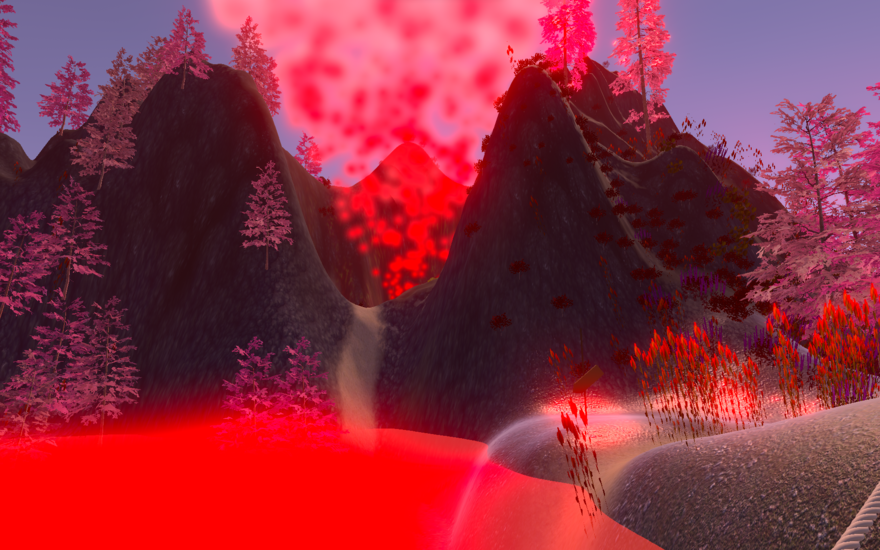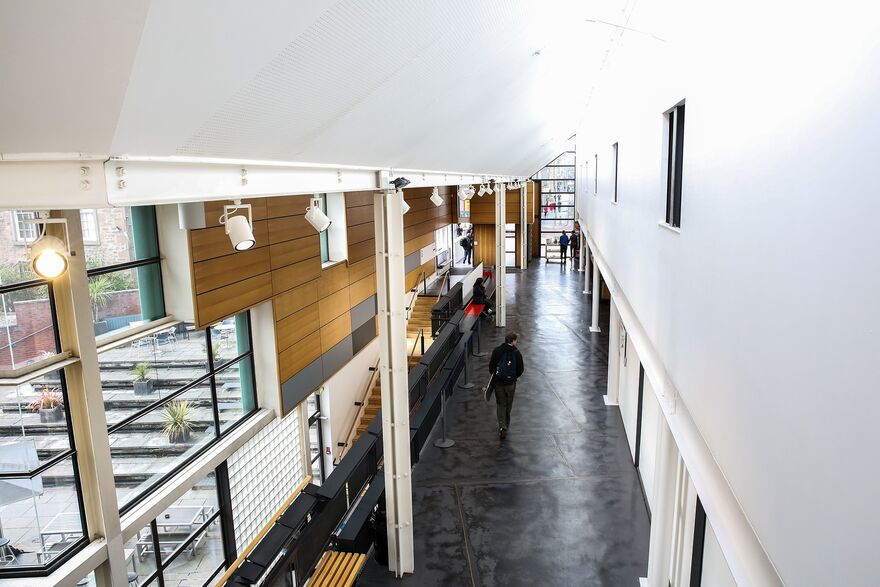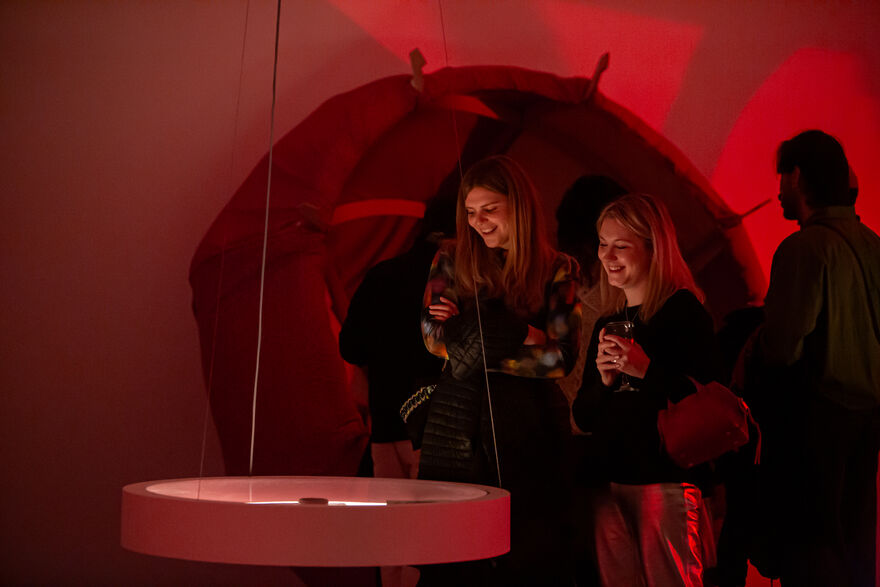
Q&A with artist Daira Ronzoni
A chat with the winner of the 2023 DCA Award
In May last year we were delighted to announce Daira Ronzoni as the 2023 recipient of the annual DCA Award.
This graduate award is selected from the Contemporary Art Practice section of Duncan of Jordanstone College of Art & Design (DJCAD) Degree show, by Beth Bate, DCA Director, and Tiffany Boyle, our Head of Exhibitions.
Daira was awarded £1500 to support her future practice, a year’s membership at DCA’s Print Studio, and professional development sessions with Tiffany.
We caught up with Daira to hear more about her work and to find out how the DCA Award has helped her practice.
Published

Can you tell us about your degree show piece?
Through the translation of sculpture, ceramics, mixed media fabrics, and digital realms, my degree show investigated the origins of culture, agriculture, and the environment.
Colours and tactility are still important elements in my work, which combines my own recollections with South American traditions to create a three-dimensional sculptural paradise-scape. Inspired by the Pachamama deity, who is envisioned as symbolising the most sacred ancestors of the earth: our soil, seeds, fruits, water, and plants.
My degree show display featured a variety of materials such as metal, ceramics, and wooden 3D sculptural pieces. The flowers and circular mosaics featured a mix of hand dyed fabrics, velvet, and other materials inspired by microorganisms generated beneath a microscope. I had various wooden sculptures in the shapes of circles and flowers inspired by Fileteado Porteño, a Buenos Aires-based movement. I imagined these blossoms illuminating the skies of this paradise-scape.
In the centre of my show, I had a floor piece inspired by the Andes Mountains and a sundial. I then pictured a gigantic version of a yerba mate cup which is a tradition of sharing and passing around a herbal drink, which was the major offering for Pachamama, where the most beautiful and vivid fruits and vegetables were to be offered. The use of so many different mediums reflect the complexities of growing up in numerous landscapes. They show how every area, but especially the history of Pachamama and the Andean mountains, is dynamic in terms of colours, shapes, patterns, and tactile substance.
It is critical to me that we not only consider our ancestral ecosystem, but also include technology to better comprehend the landscapes in which we live, and that I employ both natural and technical references in my practice. The game I made was a personal favourite of mine; it was a land where you could travel through, collect and touch fruits, and then plant a seed and grow a tree. I had programmed the game to respawn the fruits, so the game was never ending! My work was essentially about bringing a community together by practises of the past and this concept will always be vital in my work.

Tell us a little about your practice in general?
A large portion of my work stems from the abstraction of concepts inspired by my drawings and paintings, which are subsequently constructed into sculptures.
I was frequently painting and drawing everything that is fruit and bacteria, and I occasionally spent time with my mother's microscope, placing various foods, plants, and well, anything beneath, it's very fascinating! My mother is also a food scientist, so I spend time discussing my ideas and how food is related. My practice in general is changing and evolving rapidly, and I am becoming increasingly influenced by technology. Once you've created one digital universe, you'll have a million more ideas for the next.
I am incredibly excited about my upcoming project, having been influenced by the Mesoamericans' history, mythology, art, and language, particularly the Mayans and Aztecs. I'm intrigued by their ideas about cosmic landscapes and maps, Xibalba, and the Great Goddess of Teotihuacan. I have plans to combine this with mosaics, ceramics, and another game that will be a cosmic map of the world tree to create the next universe.
A big portion of my practice has been sculpture-based, and this is something I want to continue, albeit on a lesser scale, until I get the opportunity to create larger and more colourful scale work through residencies and competitions. The colours I chose for my degree show were inspired by South American culture and Pachamama, which is often compared to the sun, trees, and Earth, and will always be present in the hues I use in my work with a Chicana-futurist twist.

What contemporary artists do you admire?
I spent a lot of time in my final semester admiring the work of Tai Shani, Cecilia Vicuña, Rehana Zaman and Rae-Yen Song — who exhibited at the DCA in 2022.
I think what I found fascinating about these artists was the tactility of materials they used for their installations. Tai Shani’s practice being inspired by feminist science fiction and particularly ‘The Book of the City of Ladies’ by Christine de Pizan. As my practice evolves, I am becoming more interested in digital creations of contemporary art via digital realms such as VR/AR/AI. Some of the game artists I've been following are Danielle Brathwaite-Shirley, GLOR1A, and Josèfa Ntjam. Many of these artists are inspired by the present day, in which we’re stuck between a hyper-technological future and the practices of the past.
I am particularly interested in Claudia Martínez Garay, Jeffrey Gibson, Matthew Palladino, Cannupa Hanska Luger, Naomi Rincón-Galardo, Nick Cave, Jon Han, and Yvette Mayorga: these are artists whom I am still referencing for my upcoming projects. I also witnessed the Afrofuturist musical 'Neptune Frost' in Glasgow, and it sparked my interest in Chicana-futurism, which investigates the impact of technology and scientific innovation on Latin American life and culture.

What have you enjoyed most about studying in Dundee?
I have really enjoyed the small community in Dundee. It’s more likely that I would bump into someone in every corner and that’s what I love about it. You can really build up your art community, from Generator that’s right next door to DJCAD, the DCA or Hospitalfield which is only a town away. I have had so much support and inspiration from all the artists not only in Dundee but in Angus. There’s always something happening in Dundee, from open mics, poetry nights, open decks and I was very excited for Art NightDundee! Some artists I have been inspired by for the past years were participants so it’s a very exciting time to be a graduate in Dundee.

What's next for you?
I feel fortunate to have won the DCA award; it allows me to continue working as an artist in Dundee.
It was always my dream to stay here as I don’t think my time is up just yet, so I am very happy to have mentoring with Tiffany at DCA. I also received a Young Person Scottish Landscape award for my VR game which I began during my degree show, and is currently exhibiting at the City Arts Centre in Edinburgh until March 2024. I used the shortlist for my game to improve it; it now has a volcano with particles and steam, as well as seamless coding features for interacting with the fruits. Not long after this, I was shortlisted for Hotel Generation by Arebyte Gallery. I'll be working with Mark at New Media Scotland to put up a proposal an exhibition, which I'm extremely enthusiastic about. It will examine the ideas I've discussed, as well as inspired readings by Silvia Rivera Cusicanqui on the concept of "Ch'ixi.", and hopefully in April I could be selected for the solo show in London. Furthermore, with my DCA membership for the year, I have a few additional planned projects with galleries and cafés for other VR games, mix media mosaic work, and possible print making/laser cut.
Anything else you’d like to add?
My final year at art school really was one of the best and most important years of my degree.
After the pandemic I felt a lack in skills for the kind of art I wanted to create. I never had one discipline, I had to try out each workshop which coincidentally kept creating more ideas and more inspiration and this never stopped! But that experience taught me you could really do whatever you wanted and the support from art school was very confidence building and validating. The work and research I created here was only the beginning for me as an artist and I am very excited for the future and to see how colourful and technologically crazy my practice becomes!
Explore Daira's influences
Claudia Martínez Garay
Sat 23 August – Sun 17 November 2024
This exhibition of new and existing works marks Claudia Martínez Garay’s first major solo exhibition in Scotland.
Martínez Garay is a Peruvian artist who lives and works between Amsterdam and Lima. Her practice encompasses painting, sculpture, printmaking, video, and site-specific installation. The artist’s sculptural works frequently reference pre-Columbian aesthetics, particularly artefacts from the Incan civilisation. These sculptures are combined in larger installations in dialogue with symbolic elements derived from her research. Martínez Garay is interested in how artefacts, cultural relics, and propaganda communicate the history and social-political memory of cultures. Multiple interpretations of historical figures and artefacts are incorporated into the artist’s work, supplanting institutional narratives and notions of stewardship. The artist seeks to challenge the persistence of colonialist frameworks and official narratives informing our understanding of the pre-Columbian cultures. The fractured forms in her work signal stories and identities that have been obscured through a process of erosion, both metaphorical and literal. Martínez Garay re-animates the existing fragments of lost histories, underscoring the connections between that which can be salvaged and continued.

Rae-Yen Song
11 December 2021 - 20 March 2022
This exhibition debuted a new body of work by Glasgow-based artist Rae-Yen Song.
▷▥◉▻ gave viewers a glimpse of an alternate dimension, shaped according to the ancestral logics and imagined futures of Song’s family, which served simultaneously as a spectacle, a memorial and a refuge.


